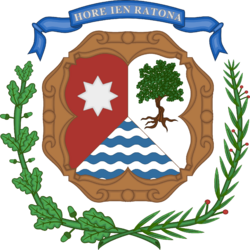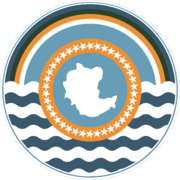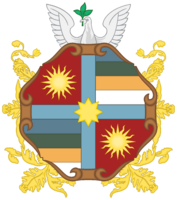National Badge of Freice: Difference between revisions
No edit summary |
No edit summary |
||
| Line 13: | Line 13: | ||
|crest = | |crest = | ||
|torse = | |torse = | ||
|blazon = Party per pall inverted, 1st Gules a star 2nd Argent a tree 3rd per fess barry wavy Azure and Argent | |blazon = | ||
|shield = Party per pall inverted, 1st Gules a star 2nd Argent a tree 3rd per fess barry wavy Azure and Argent | |||
|supporters = Wreath of oak and bay laurel branches Vert | |supporters = Wreath of oak and bay laurel branches Vert | ||
|compartment = | |compartment = | ||
| Line 23: | Line 23: | ||
|use = The emblem is used on all Acts of the [[Kivunna]] and government departments. | |use = The emblem is used on all Acts of the [[Kivunna]] and government departments. | ||
}} | }} | ||
The '''Emblem of Freice''' (Freician: Temo oe Faio), officially the '''Public Emblem of the Country of Freice''', is the national symbol of the [[Freice|Country of Freice]], used alongside and in conjunction with the [[Flag of Freice|national flag]].<ref>[https://i.imgur.com/LJrd3HN.jpg/ Law on the Establishment of National Symbols] (PDF). ''Government of Freice''. 4 September 2021. Retrieved 21 September, 2021.</ref> It was adopted in | The '''Emblem of Freice''' (Freician: Temo oe Faio), officially the '''Public Emblem of the Country of Freice''', is the national symbol of the [[Freice|Country of Freice]], used alongside and in conjunction with the [[Flag of Freice|national flag]].<ref>[https://i.imgur.com/LJrd3HN.jpg/ Law on the Establishment of National Symbols] (PDF). ''Government of Freice''. 4 September 2021. Retrieved 21 September, 2021.</ref> It was adopted in September 2022 with the passage of the Public Emblem (Specifications) Act 2022, which amended the design previously adopted in the wake of the 2021 Freician coup d'état.<ref name=": NewEmblem">[https://i.imgur.com/LJrd3HN.jpg/ "Public Emblem (Specification) Act 2022"] (PDF). ''Kivunna''. 5 September 2022. Retrieved 9 September, 2022.</ref> | ||
It bears a traditional Freician shield used by warriors during the Qaba Dance, | It bears a traditional Freician shield used by warriors during the Qaba Dance, divided into three sections. In the first is a star on a red field, the second a tree on a white field, and in the third a depiction of waves.<ref name=": AW2">[https://i.imgur.com/LJrd3HN.jpg/ "Kivunna adopts emblem changes"]. ''Radio and Television Freice''. 4 September 2022. Retrieved 6 September, 2022.</ref> The emblem is based on initial designs by Qogra Egel in 1969, with the blazon designed by Uatesi Seitema.<ref name=": 1scv23 Association">[https://i.imgur.com/LJrd3HN.jpg/ "Qogra Egel at 70"]. ''Tama Adune oe Faio''. 18 January 2014. Retrieved 2 February, 2014.</ref><ref name=": AW2">[https://i.imgur.com/LJrd3HN.jpg/ "Kivunna adopts emblem changes"]. ''Radio and Television Freice''. 4 September 2022. Retrieved 6 September, 2022.</ref> | ||
==Description== | ==Description== | ||
The emblem takes inspiration from western heraldic practices, with the blazon making use of a shield, albeit a traditional Freician shield in place of a standard three-point one. | The emblem takes inspiration from western heraldic practices, with the blazon making use of a shield, albeit a traditional Freician shield in place of a standard three-point one. | ||
The | The white star on a red background represents Freice prior to Riamese colonisation. Although no national flag was used to represent the island at this time, this design was commonly used as a heraldic banner to represent the island's monarchs. The colour red was also commonly used in the form of a solid-coloured banner to represent nobility and the elite classes.<ref>[https://i.imgur.com/LJrd3HN.jpg/ (Flag of) Freice]. ''Flags of the World''. 8 August 2016. Retrieved 13 May 2018.</ref> The design was adopted because, according to Uatesi, Freice's history prior to colonisation was driven by and primarily recorded through the activities of these classes, who provide the only known glimpse into this pre-colonial period.<ref name=": 23">[https://i.imgur.com/LJrd3HN.jpg/ "Freice abandons coup emblem"]. ''Riamo News''. 6 September 2022. Retrieved 7 September, 2022.</ref> The tree represents the growth of the nation following self-government, as well as the enduring strength of the Freician people and their long heritage. The waves are a reference to Freice's nature as an island and its dependence on the sea for sustenance.<ref name=": 23">[https://i.imgur.com/LJrd3HN.jpg/ "Freice abandons coup emblem"]. ''Riamo News''. 6 September 2022. Retrieved 7 September, 2022.</ref> | ||
Unofficially, the three sections were designed as a reference to the past, present, and future. The star, waves, and tree were designed to represent pre-colonial, colonial, and post-colonial societies. This, however, is only an informal interpretation and is not formally recognised nor does it uphold heraldic rules.<ref name=": s.">[https://i.imgur.com/LJrd3HN.jpg/ "Peka designer recreates national emblem"]. ''Kaposa Tama''. 10 September 2022. Retrieved 12 September, 2022.</ref> | |||
==History== | ==History== | ||
| Line 42: | Line 42: | ||
Following the 2021 Freician Coup d'état, the current emblem was adopted. It was formally enshrined in law with the Law on the Establishment of National Symbols on 10 August 2021 and reaffirmed in the Schedules of Government passed on 1 September 2021.<ref>[https://i.imgur.com/LJrd3HN.jpg/ Law on the Establishment of National Symbols] (PDF). ''Government of Freice''. 4 September 2021. Retrieved 21 September, 2021.</ref> | Following the 2021 Freician Coup d'état, the current emblem was adopted. It was formally enshrined in law with the Law on the Establishment of National Symbols on 10 August 2021 and reaffirmed in the Schedules of Government passed on 1 September 2021.<ref>[https://i.imgur.com/LJrd3HN.jpg/ Law on the Establishment of National Symbols] (PDF). ''Government of Freice''. 4 September 2021. Retrieved 21 September, 2021.</ref> | ||
The Kivunna voted to adopt an amended design in September 2022, maintaining the Qaba shield and wreath but with the addition of the national motto and a changed blazon. It was formally adopted on 5 September 2022 when [[Prime Minister of Freice|Head of Ministers]] [[Aniara Neileka]] and [[Kivunna|President of the Kivunna]] Siega Pokigna granted assent to the design law. | |||
==Regulations on use== | ==Regulations on use== | ||
Revision as of 11:22, 5 September 2022
| Emblem of Freice | |
|---|---|
 | |
| Armiger | Country of Freice |
| Adopted | 5 September 2022 |
| Blazon | Party per pall inverted, 1st Gules a star 2nd Argent a tree 3rd per fess barry wavy Azure and Argent |
| Supporters | Wreath of oak and bay laurel branches Vert |
| Motto | Hore ien Ratona (Common: Honour in Service) |
| Use | The emblem is used on all Acts of the Kivunna and government departments. |
The Emblem of Freice (Freician: Temo oe Faio), officially the Public Emblem of the Country of Freice, is the national symbol of the Country of Freice, used alongside and in conjunction with the national flag.[1] It was adopted in September 2022 with the passage of the Public Emblem (Specifications) Act 2022, which amended the design previously adopted in the wake of the 2021 Freician coup d'état.[2]
It bears a traditional Freician shield used by warriors during the Qaba Dance, divided into three sections. In the first is a star on a red field, the second a tree on a white field, and in the third a depiction of waves.[3] The emblem is based on initial designs by Qogra Egel in 1969, with the blazon designed by Uatesi Seitema.[4][3]
Description
The emblem takes inspiration from western heraldic practices, with the blazon making use of a shield, albeit a traditional Freician shield in place of a standard three-point one.
The white star on a red background represents Freice prior to Riamese colonisation. Although no national flag was used to represent the island at this time, this design was commonly used as a heraldic banner to represent the island's monarchs. The colour red was also commonly used in the form of a solid-coloured banner to represent nobility and the elite classes.[5] The design was adopted because, according to Uatesi, Freice's history prior to colonisation was driven by and primarily recorded through the activities of these classes, who provide the only known glimpse into this pre-colonial period.[6] The tree represents the growth of the nation following self-government, as well as the enduring strength of the Freician people and their long heritage. The waves are a reference to Freice's nature as an island and its dependence on the sea for sustenance.[6]
Unofficially, the three sections were designed as a reference to the past, present, and future. The star, waves, and tree were designed to represent pre-colonial, colonial, and post-colonial societies. This, however, is only an informal interpretation and is not formally recognised nor does it uphold heraldic rules.[7]
History
Freice was granted its first emblem in 1949 when the colonial government adopted a seal to replace the use of Riamese state symbols in Freician colonial government activities.[8] The seal featured the Riamese coat of arms with 'Government-General of Freice' around it. The seal was later adapted, with a wreath added around the Riamese coat of arms in 1958.[9]
Upon self-government in 1969, the colonial seal was retained, although heavily amended. The Riamese coat of arms was replaced with a stylised depiction of the island of Freice with the wording replaced by 'Seal of the Government of Freice.' This was an interim emblem for the exclusive use of government authorities and was not intended to be a permanent state symbol.[10] The first permanent emblem was a shield divided into two halves. In the left half was a stylisation of traditional Freician work tools on a green background. In the right half was a representation of a fishing scene.[11]
In 1980, a new emblem was adopted in line with the federal school of Riamese heraldry.[12] The seal consisted of a blue disc of the same colour as the field on the Freician national flag, representing the sea. In the bottom half of the disc was a depiction of the ocean, whilst the top half featured a depiction of the Frecian ethnic flag in the form of a rainbow, symbolizing the island's emergence from the ocean. In the centre was an orange disc featuring a circle of 38 stars, representing the 38 fish from which the Frecian people evolved in ancient tribal mythology. A further blue disc was superimposed onto this, bearing a white silhouette of the island of Freice, with the central emblem representing the island within the ocean protected by the sun and the stars.[13]
Following the 2021 Freician Coup d'état, the current emblem was adopted. It was formally enshrined in law with the Law on the Establishment of National Symbols on 10 August 2021 and reaffirmed in the Schedules of Government passed on 1 September 2021.[14]
The Kivunna voted to adopt an amended design in September 2022, maintaining the Qaba shield and wreath but with the addition of the national motto and a changed blazon. It was formally adopted on 5 September 2022 when Head of Ministers Aniara Neileka and President of the Kivunna Siega Pokigna granted assent to the design law.
Regulations on use
Although the emblem of the nation, the constitution defines it as a government symbol:
The national state emblem shall be determined by law, to be adopted for the purposes of identification of state authorities.[15]
This regulation was carried over from the previous constitution, with no mechanism for the public use of the emblem. Consequently, the use of the national emblem without government permission is illegal, although there is no record of any prosecutions for it's unilateral use. Because of its legal position, there have been calls for the creation of a 'civic emblem' to be used alongside the Freician flag to represent the Freician nation in a non-government setting.[16]
Gallery
See also
References
- ↑ Law on the Establishment of National Symbols (PDF). Government of Freice. 4 September 2021. Retrieved 21 September, 2021.
- ↑ "Public Emblem (Specification) Act 2022" (PDF). Kivunna. 5 September 2022. Retrieved 9 September, 2022.
- ↑ 3.0 3.1 "Kivunna adopts emblem changes". Radio and Television Freice. 4 September 2022. Retrieved 6 September, 2022.
- ↑ "Qogra Egel at 70". Tama Adune oe Faio. 18 January 2014. Retrieved 2 February, 2014.
- ↑ (Flag of) Freice. Flags of the World. 8 August 2016. Retrieved 13 May 2018.
- ↑ 6.0 6.1 "Freice abandons coup emblem". Riamo News. 6 September 2022. Retrieved 7 September, 2022.
- ↑ "Peka designer recreates national emblem". Kaposa Tama. 10 September 2022. Retrieved 12 September, 2022.
- ↑ "History of Freician national symbols". Institute for Freician Political and Social Studies. 13 January 2009. Retrieved 15 February, 2015.
- ↑ Sharman, Maria G. (2014) Expressions of Freician national identity'. Political and Social Centre, National Library of Riamo. 18 August 2015. Retrieved June 12, 2019.
- ↑ "Artistic developments in Freician political culture". Institute for Freician Political and Social Studies. 16 July 2005. Retrieved 28 March 2016.
- ↑ One photo (see "The Convening of the First Assembly of the Autonomous Republic of Freice, 1971,") shows the first use of this emblem (Image: Unknown).
- ↑ Svil, F.J., A History of Nativism (Saltstil University Press, 2012), p.99
- ↑ "Regulations on State Symbols" (PDF). Government of Freice. 14 January 2019. Retrieved June 19, 2019.
- ↑ Law on the Establishment of National Symbols (PDF). Government of Freice. 4 September 2021. Retrieved 21 September, 2021.
- ↑ "Constitution of the Country of Freice - Section 4(2)" (PDF). Kivunna. 28 June 2022. Retrieved 18 August 2022.
- ↑ "Calls for civic emblems to be created". Tama Adune oe Faio. 4 May 2020. Retrieved 21 June, 2020.
External links



